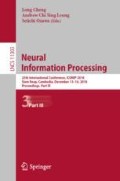Abstract
High-dimensional highly correlated data exist in several domains such as genomics. Many feature selection techniques consider correlated features as redundant and therefore need to be removed. Several studies investigate the interpretation of the correlated features in domains such as genomics, but investigating the classification capabilities of the correlated feature groups is a point of interest in several domains. In this paper, a novel method is proposed by integrating the ensemble feature ranking and co-expression networks to identify the optimal features for classification. The main advantage of the proposed method lies in the fact, that it does not consider the correlated features as redundant. But, it shows the importance of the selected correlated features to improve the performance of classification. A series of experiments on five high dimensional highly correlated datasets with different levels of imbalance ratios show that the proposed method outperformed the state-of-the-art methods.
Access this chapter
Tax calculation will be finalised at checkout
Purchases are for personal use only
References
Ambroise, C., McLachlan, G.J.: Selection bias in gene extraction on the basis of microarray gene-expression data. PNAS 99(10), 6562–6566 (2002)
Anaissi, A., Goyal, M., Catchpoole, D.R., Braytee, A., Kennedy, P.J.: Ensemble feature learning of genomic data using support vector machine. PLOS ONE 11(6), 1–17 (2016)
Bin, Z., Steve, H.: A general framework for weighted gene co-expression network analysis. Stat. Appl. Gen. Mol. Biol. 4(1), 11–28 (2005)
Boser, B.E., Guyon, I.M., Vapnik, V.N.: A training algorithm for optimal margin classifiers. In: Proceedings of the Fifth Annual Workshop on Computational Learning Theory, pp. 144–152. ACM, Pittsburgh (1992)
Braytee, A., Liu, W., Kennedy, P.J.: Supervised context-aware non-negative matrix factorization to handle high-dimensional high-correlated imbalanced biomedical data. In: 2017 International Joint Conference on Neural Networks (IJCNN), pp. 4512–4519. IEEE, Anchorage (2017)
Conn, D., Ngun, T., Li, G., Ramirez, C.: Fuzzy forests: extending random forests for correlated, high-dimensional data. UCLA Biostatistics Working Paper Series (2015)
Cui, C., Wang, D.: High dimensional data regression using lasso model and neural networks with random weights. Inf. Sci. 372, 505–517 (2016)
Golub, T.R., et al.: Molecular classification of cancer: class discovery and class prediction by gene expression monitoring. Science 286(5439), 531–537 (1999)
Guyon, I., Weston, J., Barnhill, S., Vapnik, V.: Gene selection for cancer classification using support vector machines. Mach. Learn. 46(1), 389–422 (2002)
Huang, H.H., Liu, X.Y., Liang, Y.: Feature selection and cancer classification via sparse logistic regression with the hybrid L1/2 + 2 regularization. PLOS ONE 11(5), 1–15 (2016)
Meier, L., Van De Geer, S., Bühlmann, P.: The group LASSO for logistic regression. J. R. Stat. Soc. Seri. B (Stat. Methodol.) 70(1), 53–71 (2008)
Park, M.Y., Hastie, T., Tibshirani, R.: Averaged gene expressions for regression. Biostatistics 8(2), 212–227 (2007)
Rapaport, F., Barillot, E., Vert, J.P.: Classification of arrayCGH data using fused SVM. Bioinformatics 24(13), i375–i382 (2008)
Saeys, Y., Inza, I., Larrañaga, P.: A review of feature selection techniques in bioinformatics. Bioinformatics 23(19), 2507–2517 (2007)
Shipp, M.A., et al.: Diffuse large B-cell lymphoma outcome prediction by gene-expression profiling and supervised machine learning. Nat. Med. 8(1), 68–74 (2002)
Singh, D., et al.: Gene expression correlates of clinical prostate cancer behavior. Cancer Cell 1(2), 203–209 (2002)
Tibshirani, R.: Regression shrinkage and selection via the LASSO. J. R. Stat. Soc. Ser. B (Methodological) 58(1), 267–288 (1996)
Tolosi, L., Lengauer, T.: Classification with correlated features: unreliability of feature ranking and solutions. Bioinformatics 27(14), 1986–1994 (2011)
Van De Vijver, M.J., et al.: A gene-expression signature as a predictor of survival in breast cancer. New Engl. J. Med. 347(25), 1999–2009 (2002)
Author information
Authors and Affiliations
Corresponding author
Editor information
Editors and Affiliations
Rights and permissions
Copyright information
© 2018 Springer Nature Switzerland AG
About this paper
Cite this paper
Braytee, A., Anaissi, A., Kennedy, P.J. (2018). Sparse Feature Learning Using Ensemble Model for Highly-Correlated High-Dimensional Data. In: Cheng, L., Leung, A., Ozawa, S. (eds) Neural Information Processing. ICONIP 2018. Lecture Notes in Computer Science(), vol 11303. Springer, Cham. https://doi.org/10.1007/978-3-030-04182-3_37
Download citation
DOI: https://doi.org/10.1007/978-3-030-04182-3_37
Published:
Publisher Name: Springer, Cham
Print ISBN: 978-3-030-04181-6
Online ISBN: 978-3-030-04182-3
eBook Packages: Computer ScienceComputer Science (R0)

